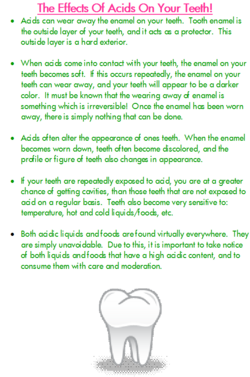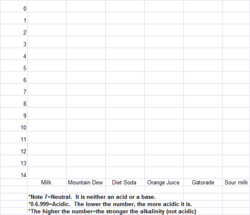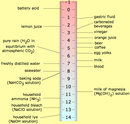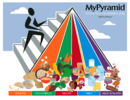Effects of Liquids on Your Body
| Instant wiki maker | Making handouts | Editing tips |
Biology In Elementary Schools is a Saint Michael's College student project from a course that ran between 2007 and 2010 and fully described in this book chapter. The student-created resources have been preserved here for posterity. Link under 'toolbox' for printer-friendly versions of the exercises. Click on handouts to print full resolution versions. Please see Wikieducator's disclaimer, our safety statement, and the Creative Commons licensing in English and in legalese.
Student worthiness
Tested and it worked
Primary biological content area covered
- This activity will raise student awareness of the effects that acids have on their teeth. We will experiment with the acidity of liquids ranging from milk to soda.
Materials
- 29.574 mL. Milk
- 29.574 mL. Mountian Dew
- 29.574 mL. Orange juice
- 29.574 mL. Diet Soda
- 29.574 mL. Gatorade
- Ph strips
- 88.721 mL. Paper cups
- Handouts
- A bucket or a sink to dump the liquids
- Measurements of 29.574 mL. per liquid are used for each group, not the class all together!
- See Figure 1
Handouts
Students will graph their results from testing the different liquids. They will graph these results on their handout, forming a bar graph. (See Figure 3) Students will also receive a handout explaining the negative impact that acids have on their teeth. (See Figure 2)
Description of activity
Students will learn what an acid is and will hypothesize which of the various liquids in this lesson contain acid, and will then test their hypothesis with pH indicator strips. Some liquids are acidic, some are neutral, and others are alkaline. Students will test some drinks on their own (milk and mountain dew) and will graph the results of the drinks that they tested and the drinks which the adults tested, forming a bar graph. Students will also learn nutritional information on acids and sugars in liquids, and will also learn the effects that acids have on their teeth.
Lesson plan
- The students will be told that they are going to test different liquids, to see if the various liquids contain acid. They will be instructed that in order to test a liquid for acid, they must use a pH indicator strip. They will learn that pH, is a scale ranging from 0-14, and that it measures the level of acidity/alkalinity within a substance, or if a substance is neutral (neither an acid or a base). When this strip of paper is dipped into each liquid, the paper will turn a specific color, and the color will be matched to the color found within the pH scale. Students will learn that anything ranging from 0-6.9999 is acidic. The lower the number, the more acidic the substance is. Seven is considerd neutral. It is neither an acid or a base. Any number ranging from 7.1 to 14 is considered alkaline (not acidic). The higher the number, the higher the alkalinity.
- Hypothesize what will happen to the pH strips when dipped in each liquid. The students will hypothesize which liquids they believe contain acid.
- Pour 29.574 milliliter each of milk, sour milk, mountain dew, orange juice, diet soda, and gatorade into separate paper cups.
- To find out if the liquids are acidic, neutral, or alkaline, they will dip a separate piece of pH paper into each.
- Compare the color of the papers or solutions to the pH indicator chart on the side of the container
- Write down the pH of each solution
- Record results on the bar graph, and compare the different liquids
- Students will be asked questions based on their results. For example: are there any bases? Are any substances neutral? Are there any acidic liquids? What are the weakest and strongest liquids?
- Students will then be asked why it is important to know if different liquids contain acid. This lesson will then be connected to the real world. The students will then learn the effects that acids have on their teeth. (See Figure 2)
- In regards to testing the sour milk, the students will learn that sour milk creates acid, and when the sour milk comes into contact with the protein found in the milk, the protein forms together into clumps.
- Photographs of the experiment in progress
Potential pitfalls
- In terms of testing the liquids for acid, it may be hard to distinguish the exact pH level of the liquid, by means of matching the color to the pH scale.
- At the second grade level, some students may have difficulty organizing their data into their graph.
- It is very important that students know that you do not test for acids by tasting them. They need to know that not all acids can be tasted, like soda and lemonade can, and that many are dangerous. While people can drink soda, other liquids can pose a danger to their health. Acidity must not be tested by means of tasting!!
Math connections
Students will be responsible for measuring out 29.574 mL of each liquid into separate paper cups. Math will also be used when reading the pH strips and filling out bar graphs comparing the various acidities of the liquids.
Nutrition connections
Soda vs. Milk:
Soda has a large amount of sugar, calories and harmful additives, making soda have absolutely no nutritional value. Studies have linked soda to obesity, tooth decay and heart disease. Soda contains:
- Phosphoric Acid, negatively affects the body's ability to use calcium, this leads to softening of the teeth and bones. Acid also breaks down your stomach and interferes with digestion, making it almost impossible to utilize nutrients.
- Sugar, soft drinks contain extreme amounts of sugar, causing problems with your teeth and your body.
- Aspartame, is a chemical used as a sugar substitute in diet soda, it is extremely harmful to your health.
- Caffeine, causes jitters, loss of vitamins and minerals, as well as many other harmful effects on your health.
Milk is the opposite of soda. Milk does not contain harmful chemicals or excessive sugars. Milk is good for your body and should be drank every day to help to build a strong body and mind. Milk contains:
- Calcium
- Vitamin D
- Protein
- Phosphorus
Which all are important nutrients to build strong bones and mind
Connections to educational standards
- S1-2:2 Students demonstrate their understanding of PREDICTING AND HYPOTHESIZING by…
- Predicting a logical outcome to a situation, using prior knowledge, experience and/or evidence. AND...Explaining reasons for that prediction.
- S1-2:5 Students demonstrate their ability to REPRESENT DATA by…
- Organizing a collection of data into a table or a graph template. AND...Creating a title for a table or graph.
- S1-2:7 Students demonstrate their ability to EXPLAIN DATA by…
- Developing a reasonable explanation based upon observations.
- Vermont Standards
Next steps
- After this lesson has been completed, a next step could be to teach students how to neutralize both acids and bases. For example, in order to neutralize an acid one must add an alkaline to it. In order to neutralize a base one must add acid to it.
- The PH for the Sour Milk was about 6, the PH for the Milk was 7, the PH for the Mountain Dew was 3, the PH for the Diet Soda was 3, the PH for the Orange Juice was 4, the PH for the Gatorade was 3. The PH varied for each one of the liquids depending on how well the students matched the PH strip to the chart.
Reflections
- While doing this lesson it worked well that the students worked together in pairs and that each of them got to fill out the chart with crayons depending on what the PH level of the drink was. It was unexpected that the students would know a lot about acids and how they can be bad for their teeth. The students knew that some drinks would be more acidic depending on the contents of the drink and this complimented the lesson by making a hypothesis about which drinks were more acidic. This activity was fun and interesting to do with the students, I even learned some new information from the students! ~Monica
- I thought that this lesson went really well. The second grade students seemed to have a lot of enthusiasm while participating in, Effects of Liquids on Your Body. Throughout the lesson, the students were constantly involved in what was taking place, as they predicted and hypothesized, matched all pH strips to the pH indicator scale to determine if the liquids were acidic, neutral, or alkaline, graphed their results, and then talked about how acids can effect their teeth. Many students knew that acids had a negative impact on their teeth, which was great to hear. At the beginning of the lesson, some students were disappointed to find out that they would not be tasting/drinking these liquids, as many of the students wanted to drink the Mountain Dew. This was a good way to tell students that although these liquids in this lesson can be tasted, many liquids that contain acids cannot be drunk, due to the harm and danger that they pose to everyones health. They learned that acids cannot be tested by means of tasting!! ~Emily
- I thought this lesson worked really well. The students seemed excited and engaged throughout the entire lesson. I thought the topic was very important for children their age to learn about, because surprisingly all of the students were drinking mountain dew and sugary drinks. i think the acid and the ph information was a little difficult to teach them about but i think overall it went really well, and was very educational. ~Maggie
- I thought this lesson went very well and really engaged each group of students we encountered. I was not sure at first if the students were going to be interested in what we had to say about the acid in drinks, but in fact they were both surprised and had a lot of thoughts on what to do after drinking such drinks like brushing their teeth and flossing. Some students were disappointed to find out that they would not be able to drink any of the drinks in front of them, but were able to continue on with the experiment anyways. Overall I believe the students learned a lot and were excited about our activity! -Amanda
Citations and links
- Handout for "Effects of Liquids on Your Body," developed from:











